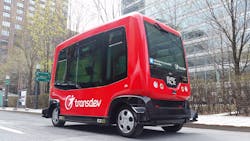Walking the Line
Autonomous buses, vehicles, drones, Uber Elevate, Hyperloop, Sea Bubbles, there are stories in the news everyday about tomorrow’s mobility options being tested, pursued and used today.
The technology is being developed for various reasons, including improved safety, improved efficiency and getting people to where they want to go faster.
The research and testing is creating a lot of discussion. How will these technologies improve safety or efficiency? How much do they cost? What are the infrastructure requirements? What kind of regulations need to be in place?
I recently got back from riding in a couple of autonomous shuttles at the UITP Global Public Transport Summit in Montréal, Canada. It’s novel, it’s fun, it’s easy and in the right setting it would be a great way to move around.
Some of these technology discussions are also creating a lot of response from planners, engineers and transportation professionals, pointing out that for the cost and infrastructure upheaval, there are current options that could provide more economical and efficient mobility for the communities they serve.
With what’s going around on social media, I’ve had friends and family comment about driverless buses coming to the streets. People are visualizing the typical 40-foot fixed-route bus making its way through the city sans driver.
While it could lead to driverless buses, utilizing the technology as an enhancement with an onboard driver, is still transformative. And with city streets and transit operations being a complicated environment, it’s likely there would still be someone onboard, whether as a driver or more of a customer service/safety role.
Enhancing the information to the operator for obstacles he or she may miss, and providing real-time information on the vehicle’s many systems to keep everything running or to notify maintenance before a component failure.
I’m usually one wanting to see what the latest technological advances can do. While buses on the road is the biggest responsibility of the majority of our readers, I know it’s important to also focus on what the other impacts are, such as bike share or TNCs or Hyperloop and autonomous technology.
It’s a delicate balance between flashy and practical. Enough to catch people otherwise not inclined to consider transit, but not too much extravagance that it wastes an unnecessary amount of money that could be used to otherwise increase service levels.
